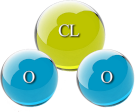IS SODIUM CHLORITE THE SAME AS SODIUM HYPOCHLORITE?
From dioxipedia
No way! They are absolutely not the same and should definitely not be confused with one another, as they are two distinct and different substances that serve different purposes. Hypochlorite is commonly known as bleach, which is widely used for its powerful disinfecting properties and its ability to whiten fabrics.
Hypochlorite
- Chemical Formula: Sodium hypochlorite (NaClO).
- Structure: One chlorine atom, one oxygen atom, and a sodium ion.
- Uses: Commonly used as a disinfectant and bleach.
Chlorine
- Chemical Formula: Cl₂ (diatomic molecule).
- Structure: Two chlorine atoms bonded together.
- Uses: Used for water treatment and disinfection.
Chlorate
- Chemical Formula: Sodium chlorate (NaClO₃).
- Structure: One chlorine atom bonded to three oxygen atoms.
- Uses: Strong oxidizer, used in herbicides and explosives.
Chlorite
- Chemical Formula: Sodium chlorite (NaClO₂).
- Structure: One chlorine atom bonded to two oxygen atoms.
- Uses: Primarily used as a precursor to chlorine dioxide (CDS), which is used for disinfection and bleaching. It is also utilized in water treatment processes.
- Reactivity: Chlorite is less reactive than hypochlorite but can release chlorine dioxide when treated with an acid.
Summary of Differences
- Hypochlorite is mainly for disinfection and bleaching.
- Chlorine is a reactive gas used in various applications.
- Chlorate is an oxidizer for industrial use.
- Chlorite serves as a precursor to chlorine dioxide, used in water treatment and disinfection.
These substances are distinct in their chemical structures and applications, which is essential for their safe and effective use.
